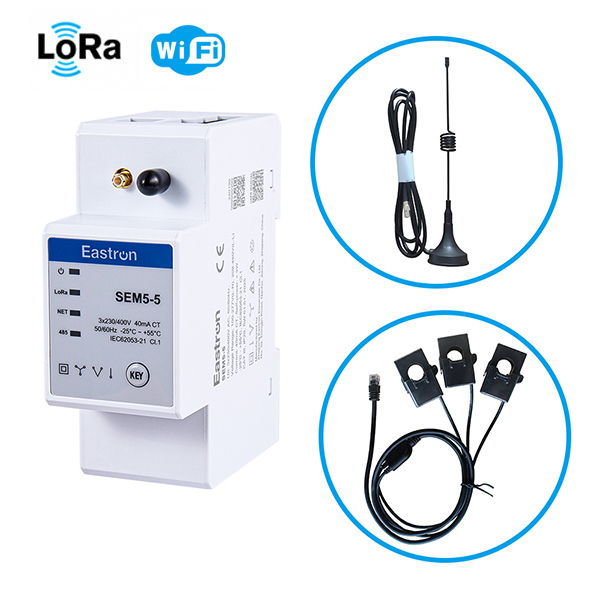Product Consultation
Your email address will not be published. Required fields are marked *
A smart panel meter is an advanced digital instrument designed to monitor, measure, and communicate electrical parameters within a power distribution system. Unlike traditional analog or basic digital meters, which typically provide only local and limited measurement of electrical values such as voltage, current, and frequency, smart panel meters offer a much broader range of capabilities, making them a key component in modern electrical infrastructure and energy management systems.
What is a Smart Panel Meter?
At its core, a smart panel meter performs the fundamental task of measuring electrical quantities—such as current, voltage, active and reactive power, frequency, power factor, and total energy consumption (kWh). However, it extends far beyond these functions by incorporating intelligent features such as digital communication, onboard data storage, advanced display interfaces, and programmable settings. These meters are designed for integration with building automation systems (BAS), industrial control systems, energy management systems (EMS), and smart grids.
Smart panel meters are often used in commercial buildings, manufacturing facilities, data centers, public infrastructure, and even residential complexes where advanced energy monitoring and optimization are required. They provide operators, engineers, and energy managers with detailed insights into energy usage patterns, peak demand times, and power quality conditions—allowing for more informed decision-making and system optimization.
Differences Between Smart Panel Meters and Traditional Panel Meters
| Category | Traditional Panel Meter | Smart Panel Meter |
| Display Type | Analog needle or basic digital numeric display | High-resolution LCD or LED with multi-parameter real-time data |
| Measurement Capabilities | Typically measures only a single value (e.g., voltage or current) | Measures multiple parameters: voltage, current, power, energy, harmonics, power factor, frequency, etc. |
| Communication | No communication capabilities | Supports RS485, Modbus RTU, Modbus TCP/IP, BACnet, Profibus, Ethernet, Wi-Fi |
| Data Logging | No data recording | Built-in memory for time-stamped logging of data over minutes, hours, or days |
| Remote Access | Not available | Data can be accessed remotely through network connections or cloud platforms |
| Alarming and Notifications | None; issues must be visually detected by an operator | Programmable alarms for overvoltage, undervoltage, current overload, harmonic distortion, etc. with notifications via system integration |
| User Interface | Manual reading required on-site | Digital menu navigation, touch buttons, remote configuration through PC or apps |
| Integration Capability | Standalone, no connectivity | Seamlessly integrates into EMS, SCADA, and smart grid platforms for real-time monitoring and control |
| Power Quality Analysis | Not possible | Advanced models offer THD (total harmonic distortion), unbalance detection, and waveform capture |
Why the Difference Matters
The enhanced capabilities of smart panel meters make them essential in today’s energy-conscious environments. With rising energy costs, the need to reduce carbon footprints, and the increased complexity of electrical systems due to the integration of renewable energy sources and automation, traditional meters are no longer sufficient for detailed system monitoring or optimization.
Smart meters allow facility managers to monitor real-time energy consumption trends and identify inefficiencies. They support automated demand response strategies, enable power factor correction, and even help prevent downtime by alerting personnel to abnormal system behaviors before they lead to failure. Moreover, smart panel meters contribute to regulatory compliance and sustainability reporting, as they generate accurate energy consumption records and power quality data.
Practical Applications of Smart Panel Meters
Energy Management: By integrating smart panel meters with centralized energy management systems, users can track usage across multiple circuits or buildings, enabling benchmarking, load analysis, and targeted energy-saving actions.
Cost Allocation and Sub-Metering: In commercial properties or industrial parks, smart meters can allocate energy costs fairly among tenants or departments based on actual usage.
Preventive Maintenance: Voltage imbalances, harmonic distortions, or sudden changes in power consumption can be detected early, helping prevent equipment damage or system failure.
Smart Grid Compatibility: With their ability to communicate bidirectionally, smart panel meters are well-suited for smart grid applications, providing valuable data for utility companies and enabling remote control functions when necessary.

Conclusion
In summary, while a traditional panel meter serves as a basic diagnostic tool limited to manual, local readings, a smart panel meter acts as a multi-functional data node within an intelligent power distribution system. The smart panel meter’s ability to measure complex parameters, store data, communicate with external systems, and provide remote access to real-time insights makes it a crucial component for optimizing energy usage, enhancing system reliability, and supporting digital transformation in both industrial and commercial electrical networks. As electrical infrastructures continue to evolve toward automation and sustainability, the adoption of smart panel meters is expected to become increasingly standard across all sectors.
Your email address will not be published. Required fields are marked *
We develop and produce high performance electricity meters, power analyzers, current sensors, communication modules and management systems. China Custom Smart Meters Manufacturers and Factory
Eastron China (HQ) : NO 52, Dongjin Road, Nanhu, Jiaxing, Zhejiang, China
Eastron UK : Suite 1 Cornwallis House, Howard Chase, Basildon, UK
Eastron EU : Unit 3 Finglas Business Centre, Jamestown Road, Finglas, Dublin, Ireland
Copyright @ Eastron Electronic Co., Ltd. All rights reserved Electricity Meters Manufacturers
